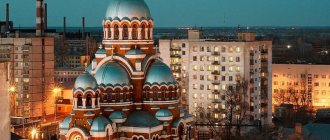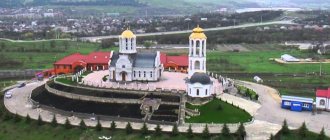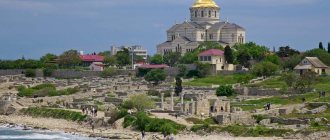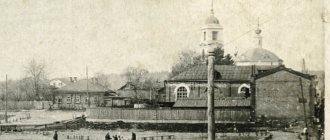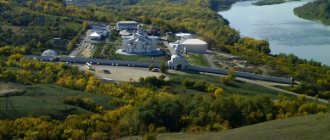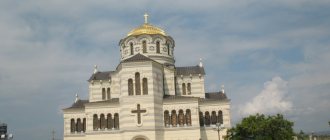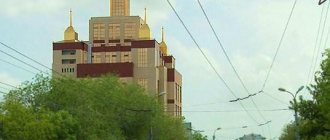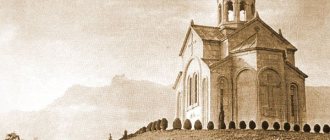Mir
Russia Kaluga Region Kaluga St. George's Cathedral (Kaluga) Map is loading...
{"format":"leaflet","minzoom":false,"maxzoom":false,"limit":50,"offset":0,"link":"all","sort":[""], "order":[],"headers":"show","mainlabel":"","intro":"","outro":"","searchlabel":"\u2026 \u0441\u043b\u0435\ u0434\u0443\u044e\u0449\u0438\u0435 \u0440\u0435\u0437\u0443\u043b\u044c\u0442\u0430\u0442\u044b","default":"","import-annotation":false,"width ":"auto","height":"350px","centre":{"text":"","title":"""link":"""lat":54.51299000000000205545802600681781768798828125,"lon": 36.24385000000000189857018995098769664764404296875,"icon":""},"title":"","label":"","icon":"","lines":[],"polygons":[],"circles":[ ],"rectangles":[],"copycoords":false,"static":false,"zoom":8,"defzoom":14,"layers":["OpenStreetMap"],"image layers":[] ,"overlays":[],"resizable":false,"fullscreen":true,"scrollwheelzoom":true,"cluster":false,"clustermaxzoom":9,"clusterzoomonclick":true,"clustermaxradius":80, "clusterspiderfy":true,"geojson":"","clicktarget":"","showtitle":true,"hidenamespace":false,"template":"","userparam":"","activeicon": "","pagelabel":false,"ajaxcoordproperty":"","ajaxquery":"","locations":[{"text":"\u003Cb\u003E\u003Ca href=\"/palomnik/%D0% A1%D0%B2%D1%8F%D1%82%D0%BE-%D0%93%D0%B5%D0%BE%D1%80%D0%B3%D0%B8%D0%B5%D0%B2 %D1%81%D0%BA%D0%B8%D0%B9_%D1%81%D0%BE%D0%B1%D0%BE%D1%80_(%D0%9A%D0%B0%D0%BB% D1%83%D0%B3%D0%B0)\» title=\»\u0421\u0432\u044f\u0442\u043e-\u0413\u0435\u043e\u0440\u0433\u0438\u0435\u0432\u0441\u043a\ u0438\u0439 \u0441\u043e\u0431\u043e\u0440 (\u041a\u0430\u043b\u0443\u0433\u0430)\»\u003E\u0421\u0432\u044f\u0442\u043e-\u041 3\u0435\u043e\u0440 \u0433\u0438\u0435\u0432\u0441\u043a\u0438\u0439 \u0441\u043e\u0431\u043e\u0440 (\u041a\u0430\u043b\u0443\u0433\u0430)\u003C /a\u003E\u003C/b \u003E\u003Chr /\u003E\u003Ca href=\"/palomnik/%D0%A1%D0%B2%D0%BE%D0%B9%D1%81%D1%82%D0%B2%D0%BE:% D0%90%D0%BD%D0%BD%D0%BE%D1%82%D0%B0%D1%86%D0%B8%D1%8F\" title=\"\u0421\u0432\u043e\u0439\ u0441\u0442\u0432\u043e:\u0410\u043d\u043d\u043e\u0442\u0430\u0446\u0438\u044f\»\u003E\u0410\u043d\u043d\u043e\u0442\u0430\u 0446\u0438\u044f\u003C /a\u003E: "'\u0421\u0432\u044f\u0442\u043e-\u0413\u0435\u043e\u0440\u0433\u0438\u0435\u0432\u0441\u043a\u0438\u0439\u0441\u 043e\u0431\u043e \u0440"', \u043d\u0430\u0437\u044b\u0432\u0430\u0435\u043c\u044b\u0439\u003Cspan class=\"smw-highlighter\" data-type=\"2\" data-state=\ »persistent\» data-title=\»\u0418\u043d\u0444\u043e\u0440\u043c\u0430\u0446\u0438\u044f\» title=\»\u0026#039;\u0026#039;\u0026#039 ;\u0421\u0432\u044f\u0442\u043e-\u0413\u0435\u043e\u0440\u0433\u0438\u0435\u0432\u0441\u043a\u0438\u0439 \u0441\u043e\u0431\ u043e\u0440\u0026#039 ;\u0026#039;\u0026#039;, \u043d\u0430\u0437\u044b\u0432\u0430\u0435\u043c\u044b\u0439 \u0442\u0430\u043a\u0436\u0435 \u0441\ u043e\u0431\u043e \u0440\u043e\u043c \u0432 \u0447\u0435\u0441\u0442\u044c \u0432\u0435\u043b\u0438\u043a\u043e\u043c\u0443\u0447\u0435\u043d \u0438\u043a\u0430 \u0413\u0435 \u043e\u0440\u0433\u0438\u044f \u00ab\u0437\u0430 \u0432\u0435\u0440\u0445\u043e\u043c\u00bb, \u043f\u043e\u0441\u0442\u0440\ u043e\u0435\u043d\u0432 1701 \u0433\u043e\u0434\u0443. \u041f\u043e \u043f\u0440\u0435\u0434\u0430\u043d\u0438\u044e, \u0441\u0442\u0440\u043e\u0438\u0442\u0435\u043b\u0435\u043c \u0441\u043e\u0431\u043e\ u0440\u0430 \u0431\u044b\u043b \u0437\u0435\u043c\u0441\u043a\u043e\u0439 \u0441\u0442\u0430\u0440\u043e\u0441\u0442\u0430 \ u0418\u0432\u0430\u043d\u041a\ u0438\u0440\u0438\u043b\u043b\u043e\u0432\u0438\u0447 \u041a\u043e\u0440\u043e\u0431\u043e\u0432. \u041d\u0430 \u043c\u0435\u0441\u0442\u043d\u043e\u043c \u0434\u0438\u0430\u043b\u0435\u043a\u0442\u0435 \u0441\u043b\u043e \u0432\u043e \u00ab\u0432\u0435 \u0440\u0445\u00bb \u043e\u0437\u043d\u0430\u0447\u0430\u043b\u043e \u043e\u0432\u0440\u0430\u0433, \u0442\u0430\u043a\u0438 \u043c \u043e\u0431\u0440\ u0430\u0437\u043e\u043c \u043d\u0430\u0437\u0432\u0430\u043d\u0438\u0435 \u0441\u0432\u044f\u0437\u0430\u043d\u043e \u0441 \ u043e\u0441\u043e\u0431\u0435\ u043d\u043d\u043e\u0441\u0442\u044f\u043c\u0438 \u0440\u0435\u043b\u044c\u0435\u0444\u0430 \u0433\u043e\u0440\u043e\u0434\u0 430.\»\u003E\u003Cspan class= \"smwtext\"\u003E\u2026 \u003C/span\u003E\u003Cspan class=\"smwttcontent\"\u003E"'\u0421\u0432\u044f\u0442\u043e-\u0413\u0435\u043e\u0440\u0 433\ u0438\u0435\u0432\u0441\u043a\u0438\u0439 \u0441\u043e\u0431\u043e\u0440'', \u043d\u0430\u0437\u044b\u0432\u0430\u0435\u043c \u044b\u0439 \u0442\u0430 \u043a\u0436\u0435 \u0441\u043e\u0431\u043e\u0440\u043e\u043c \u0432 \u0447\u0435\u0441\u0442\u044c \u0432\u0435\u043b\u043 8\u043a\u043e\u043c\u0443\u0447 \u0435\u043d\u0438\u043a\u0430 \u0413\u0435\u043e\u0440\u0433\u0438\u044f \u00ab\u0437\u0430 \u0432\u0435\u0440\u0445\u043e\ u043c\u00bb,\u043f\u043e\ u0441\u0442\u0440\u043e\u0435\u043d \u0432 1701 \u0433\u043e\u0434\u0443. \u041f\u043e \u043f\u0440\u0435\u0434\u0430\u043d\u0438\u044e, \u0441\u0442\u0440\u043e\u0438\u0442\u0435\u043b\u0435\u043c \u0441\u043e\u0431\u043e\ u0440\u0430 \u0431\u044b\u043b \u0437\u0435\u043c\u0441\u043a\u043e\u0439 \u0441\u0442\u0430\u0440\u043e\u0441\u0442\u0430 \ u0418\u0432\u0430\u043d\u041a\ u0438\u0440\u0438\u043b\u043b\u043e\u0432\u0438\u0447 \u041a\u043e\u0440\u043e\u0431\u043e\u0432. \u041d\u0430 \u043c\u0435\u0441\u0442\u043d\u043e\u043c \u0434\u0438\u0430\u043b\u0435\u043a\u0442\u0435 \u0441\u043b\u043e \u0432\u043e \u00ab\u0432\u0435 \u0440\u0445\u00bb \u043e\u0437\u043d\u0430\u0447\u0430\u043b\u043e \u043e\u0432\u0440\u0430\u0433, \u0442\u0430\u043a\u0438 \u043c \u043e\u0431\u0440\ u0430\u0437\u043e\u043c \u043d\u0430\u0437\u0432\u0430\u043d\u0438\u0435 \u0441\u0432\u044f\u0437\u0430\u043d\u043e \u0441 \ u043e\u0441\u043e\u0431\u0435\ u043d\u043d\u043e\u0441\u0442\u044f\u043c\u0438 \u0440\u0435\u043b\u044c\u0435\u0444\u0430 \u0433\u043e\u0440\u043e\u0434\u0 430.\u003C/span\u003E\u003C /span\u003E\u0438\u0435 \u0441\u0432\u044f\u0437\u0430\u043d\u043e \u0441 \u043e\u0441\u043e\u0431\u0435\u043d\u043d\u043e\u04 41\u0442\u044f\u043c\u0438 \u0440\u0435\u043b\u044c\u0435\u0444\u0430 \u0433\u043e\u0440\u043e\u0434\u0430.","title":"\u0421\u0432\u044f\u0442\u043e-\u0413 \u0435\ u043e\u0440\u0433\u0438\u0435\u0432\u0441\u043a\u0438\u0439 \u0441\u043e\u0431\u043e\u0440 (\u041a\u0430\u043b\u0443\u0433\u0 430)","link":" ","lat":54.51299000000000205545802600681781768798828125,"lon":36.24385000000000189857018995098769664764404296875,"icon":""}],"imageLayers ":[]}
54.512967; 36.243635
Russia, Kaluga, Bauman street, 14
Kaluga, Kaluga region 248000
Russia
Telephone:
+79206171688
Email:
St. George's Cathedral
, also called the cathedral in honor of the Great Martyr George “on horseback,” built in 1701. According to legend, the builder of the cathedral was the zemstvo elder Ivan Kirillovich Korobov. In the local dialect, the word “upper” meant a ravine, so the name is associated with the peculiarities of the city’s topography.
History[edit]
The first mention of the current stone church dates back to 1701. According to legend, it was built by the Kaluga zemstvo elder Ivan Kirillovich Korobov. The name of the temple is associated with the topographical features of the city - the word “top” in the local peasant dialect meant a ravine, therefore, the addition “behind the top” means “behind the ravine.”
From a distance, the two-story stone church with a hipped bell tower attracts attention with its slender proportions and rich architectural details. The temple is made in the style of buildings from the time of Alexei Mikhailovich or in the “Moscow Baroque” style. The body of the temple and its exterior decoration have been preserved almost completely.
The top floor is occupied by only one chapel - in the name of the Exaltation of the Holy Cross. There are three chapels on the lower floor: the main one in the name of the Great Martyr George the Victorious, the southern one in the name of the icon of the Mother of God “Quench My Sorrows” and the northern one in the name of John the Baptist. The southern and northern aisles in the lower church were built in 1824. The upper church was painted, as the inscription in the altar and on the walls shows, in 1766-1767. In 1880-1881 it was washed and renewed, without departing from the ancient script. Later it was also renewed several times, so now it is difficult to judge the quality of the painting of the 20s. XVIII century The lower temple was painted at the beginning of the 20th century. The refectory part of the lower church was again painted in 1999 by icon painters of the Kaluga diocese.
The bell tower of St. George's Cathedral is one of the most brilliant examples of architecture common in the 17th century. architectural type. The three-tiered quadrangle easily carries an octagonal bell, completed with a high tent top. On the roof of the bell tower, double quadrangular and round bays of dormer windows are symmetrically located. The lower tier of the bell tower is reinforced with a buttress, i.e. a transverse vertical beveled wall, giving the architecture of the temple the appearance of an ancient fortress wall. There are windows in the second and third tiers: two windows in the second and one in the third. The window frames are decorated with small columns.
From 1926 to 1999 the cathedral was a cathedral. 1934-1937 associated with the stay of the Hieromartyr Augustine (Belyaev) at the Kaluga cathedral. During these terrible years for the Russian Church, the cathedral began to be filled again with people whom the Bishop, by his example, taught not to be afraid to openly profess their faith. People brought flowers to the cathedral and decorated icons and the bishop's pulpit. At a time when other churches were being destroyed, St. George's Cathedral, thanks to Bishop Augustine, testified to ongoing spiritual life. Hieromartyr Augustine was shot on November 23, 1937 by the verdict of the NKVD troika of the Tula region. Together with him, the clergy of the cathedral were arrested: Archpriest John Speransky, Archpriest John Ostroglazov, Archpriest Pavel Semenovsky, priest Afanasy Lyubimov, priest Vasily Makarov and his brother Yakov, priest Alexander Pokrovsky, deacon Vasily Stanovov, psalm-reader Babichev A.K., elder Tashchina Z .M., member of the church council Filatova E.A., regent Vinogradov A.F., Sukhov M.P., choirmaster Smirnov. Many of them were subsequently shot along with the holy martyr Augustine.
From 1937 to 1942 - the time when the Kaluga See remained idle - about a dozen priests changed in the cathedral. After the arrest of the bishop and clergy, the service in the St. George Cathedral began to be performed in turn by the priests of the Nikolo-Kozinsky Church - Archpriest Alexander Kedrov and Hieromartyr Archimandrite Ioaniky (Dmitriev). Soon Fr. Ioannikis was arrested and prosecuted in the case of the Hieromartyr Augustine. Priest V.V. Volkov was appointed in his place, but he too was arrested ten days later.
Since November 1937, the former priest of the Church of the Great Martyr George on Vorobyovka, Archpriest P.A., served in the St. George Cathedral. Dobronravov, who served in the cathedral until the spring of 1939. After him, the Patriarchate sent priest K.A. Christmas. And in 1940, Archpriest Anthony Popov was appointed to his place.
In February 1940, St. George's Cathedral was closed for a short time. After the opening (in the same 1940), Abbot Procopius (Zimin), who came from Moscow at the request of the headman of the Nikolo-Kozinsky Church, D.D. Shumakova, served in the cathedral. Hegumen Procopius served in the cathedral for three weeks, then his place was taken by Archpriest A.M., who arrived from Volokolamsk. Anokhin, who served here until November 18, 1940. At the end of January 1941, Archpriest Joseph Kunitsky began serving in the cathedral. On May 21, 1941, Archpriest I.S. arrived in Kaluga. Soloviev and soon began to serve together with Fr. Joseph. At the same time, Archpriest G.K. arrived. Lysyak, who then temporarily worked as a watchman at the cathedral.
In October 1941, Fr. returned from the Smolensk region to Kaluga. A.M. Anokhin and, when he was in his old age, Fr. Joseph finally fell ill and was enrolled in the staff of St. George's Cathedral. Father Joseph died on November 2, 1942. At that time, the regular priests of the cathedral were Archpriest G.K. Lysyak and Archpriest A.M. Anokhin.
In 1950, under Bishop Onisiphorus (Ponomarev), the dome of the cathedral was carefully repaired, the painting was renewed, and the wall painting was washed and restored. For the celebration of the millennium of the Baptism of Rus', the temple was renovated. From the outside, the entire temple was plastered and painted red, the roof was covered, including the domes. Instead of the dilapidated central cross, a new one was placed above the dome, which was soon gilded. All the wall paintings of the upper temple were washed and renewed, in some places they were painted anew, and new paintings were made on the western wall of the altar. In the middle is the Exaltation of the Honorable and Life-Giving Cross of the Lord, on the right side are the Great Martyr George the Victorious and the Venerable Paphnutius of Borovsky, on the left are the Righteous Lavrentiy of Kaluga and the Venerable Tikhon of Kaluga. At the same time, the iconostasis, icon cases and all temple icons were restored.
The cathedral houses the main shrine of the Kaluga land - the miraculous Kaluga Icon of the Mother of God. Of the icons of the lower church, the following are especially revered: the icon of the Mother of God “Quench My Sorrows” (was painted by order of the merchant Sysoev, who received a miraculous healing abroad in Konigsberg), the icon of St. Nicholas the Wonderworker, the icon of the Savior, the icons of the Great Martyr George, the holy martyrs Guria, Samon and Aviva, Great Martyr Paraskeva Friday.
In the upper church, one of the revered ones is the Jerusalem Icon of the Mother of God, painted in 1740 by the icon painter Semyon Faleev. Since 1960, the cathedral has been a monument of architecture and urban planning of republican significance (Resolution of the Council of Ministers of the RSFSR dated August 30, 1960 No. 1327).
On May 20, 1999, a cross erected near St. George’s Cathedral was consecrated, dedicated to the memory of “the right reverend archpastors, pastors and everyone who worked in the Kaluga diocese.” Thus began the celebration of the 200th anniversary of the establishment of the Kaluga diocese.
Before the revolution of 1917, the Church of St. George “beyond the top” was not a cathedral. It received the status of a cathedral in the 20s. XX century after the closure of the Holy Trinity Cathedral. In 1999, when the Holy Trinity Cathedral was restored and again became a cathedral, the Church of St. George “beyond the top”, by the decision of the Administrator of the Kaluga Diocese, retained the status of a cathedral.
At the end of the 19th century. During his visit to Kaluga, the holy righteous John of Kronstadt served in the cathedral; in memory of this event, in the altar of the cathedral there is a bronze tablet with the inscription: “Father John of Kronstadt celebrated the Divine Liturgy in this church on May 15, 1895.” The first hierarchs of the Local Orthodox Churches also served in the cathedral: - His Holiness Patriarch Alexy II of Moscow and All Rus' (repeatedly), His Beatitude Metropolitan Theodosius of Washington and All America (1992), His Beatitude Pope and Patriarch of Alexandria and All Africa Parthenius III (1994).
On January 29, 2007, by Decree No. 89-r, the Government of the Russian Federation transferred the temple into the ownership of the Kaluga Diocese of the Russian Orthodox Church.
Description of the temple
From a distance, the two-story stone church with a hipped bell tower attracts attention with its slender proportions and rich architectural details.
The temple is made in the style of buildings from the time of Alexei Mikhailovich or in the “Moscow Baroque” style. The body of the temple and its exterior decoration have been preserved almost completely. The temple is five-domed, has the shape of a half-ship, about 43 m high, just over 32 m long, on the sides of the upper floor there are galleries resting on four Romanesque arches, through which light passes into the windows of the lower floor. The galleries were at first open, but at the end of 1776 they were covered with a roof, which is supported by five quadrangular columns on each side. After the Great Patriotic War, the gallery was completely glazed. The galleries and the temple on the second floor are accessed from both sides by staircases, the railings of which cover a balustrade of balusters with cubes. The main entrance to the lower temple was “from under the bell tower,” as evidenced by the arch in the first tier of the bell tower, now blocked. The outer walls of the upper church are decorated with crosses. The temple is surrounded by a jagged belt of five bricks per corner. There are voices in the walls of the upper temple. The roof of the temple is hipped, topped with five domes. The kokoshniks in the upper part of the quadrangle facades are reinforced with shell-shaped inserts. It should be noted that new trends, unknown at the end of the 1680s, were clearly evident here. The spacious altar retains the traditional three-part division, although here it is already a single room. The decoration of the doors in both the lower and upper churches is made in the Russian style from Myachkovsky stone. The doors remain intact, painted as they were.
The top floor is occupied by only one chapel - in the name of the Exaltation of the Holy Cross. There are three chapels on the lower floor: the main one in the name of the Great Martyr George the Victorious, the southern one in the name of the icon of the Mother of God “Quench My Sorrows” and the northern one in the name of John the Baptist. The southern and northern aisles in the lower church were built in 1824. The upper church was painted, as the inscription in the altar and on the walls shows, in 1766-1767. In 1880-1881 it was washed and renewed, without departing from the ancient script. Later it was also renewed several times, so now it is difficult to judge the quality of the painting of the 20s. XVIII century The lower temple was painted at the beginning of the century. The refectory part of the lower church was again painted in 1999 by icon painters of the Kaluga diocese.
The five-tiered iconostasis of the upper church dates back to 1770-1780. Its rather magnificent ceiling carvings are made in the Moscow Baroque style. Most of the icons that we see in the iconostasis of the upper church were painted specifically for it. In the lower church, after the completion of the construction of the stone cathedral, the icons for the three-tiered iconostasis were transferred, according to legend, from the previous wooden church. And judging by the two restored icons of the lower church - the Great Martyr George the Victorious and the Great Martyr Paraskeva Pyatnitsa, dated by specialists to the late 16th and early 17th centuries. - then this legend can be considered reliable.
The bell tower of St. George's Cathedral is one of the most brilliant examples of architecture common in the 17th century. architectural type. The three-tiered quadrangle easily carries an octagonal bell, completed with a high tent top. On the roof of the bell tower there are double quadrangular and round bays of dormer windows symmetrically located. The lower tier of the bell tower is reinforced with a buttress, i.e. a transverse vertical beveled wall, giving the architecture of the temple the appearance of an ancient fortress wall. There are windows in the second and third tiers: two windows in the second and one in the third. The window frames are decorated with small columns.
Activities of the parish[edit]
Sunday School
at the cathedral was opened through the diligence of Archbishop Clement of Kaluga and Borovsk (now Metropolitan) in September 1990. She became the first in the Kaluga diocese after a many-year break. Until 1918, a parochial school operated at the St. George Church. It was located in a building located in the courtyard of the cathedral, built in the 18th century. with funds collected by the clergy (Georgievskaya St., 12).
Currently, the building has been partially returned to the Church, and the school is located there.
Notes
- ↑ 1 2 3
St. George's Cathedral
(unspecified)
. Website of the Kaluga diocese. Date accessed: May 14, 2021. - Malinin D.I.
Kaluga. Experience of a historical guide to Kaluga and the main centers of the province / Intro. Art. and comment: Larin A.K. and others... - Kaluga: Golden Alley, 1992. - P. 54−55. — 15,000 copies. - ↑ 123
Church of St. George on Horseback // Kaluga Encyclopedia / ed. V. Ya. Filimonova. — 2nd ed., revised. and additional - Kaluga: Publishing House N.F. Bochkareva, 2005. - P. 455. - 494 p. — 3100 copies. — ISBN 5-89552-333-1. - Materials for geography and statistics of Russia, collected by officers of the General Staff. Kaluga province. Part 2 / comp. M. Poprocki. - SPb.: Type. E. Weimar, 1864. - P. 400. - 770 p.
- ↑ 1 2 3 Fechner M.V.
Kaluga. - M.: Stroyizdat, 1971. - P. 55−60. — 224 p. - (Cities of the USSR). - Clergy | St. George's Cathedral in Kaluga (unspecified)
. georgsobor.cerkov.ru. Date accessed: February 27, 2021.
Patronal holidays[edit]
St. George the Victorious, Great Martyr
- the 6th of May
Icon of the Blessed Virgin Mary “Kaluga”
— July 31, October 25, September 15
Nativity of John the Baptist
— July 7
Icon of the Most Holy Theotokos “Quench My Sorrows”
— February 7
Exaltation of the Life-Giving Cross of the Lord
- September 27
Shrines
The cathedral houses the main shrine of the Kaluga land - the miraculous Kaluga Icon of the Mother of God.
Of the icons of the lower church, the following are especially revered: the icon of the Mother of God “Quench My Sorrows” (was painted by order of the merchant Sysoev, who received a miraculous healing abroad in Konigsberg), the icon of St. Nicholas the Wonderworker, the icon of the Savior, the icons of the Great Martyr George, the holy martyrs Guria, Samon and Aviva, Great Martyr Paraskeva Friday. In the upper church, one of the revered ones is the Jerusalem Icon of the Mother of God, painted in 1740 by the icon painter Semyon Faleev. The altar contained: an altar cross with particles of the relics of nine Pechersk saints.
